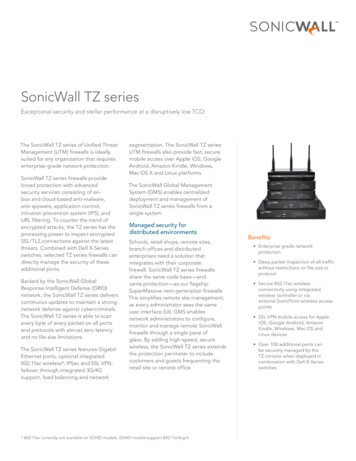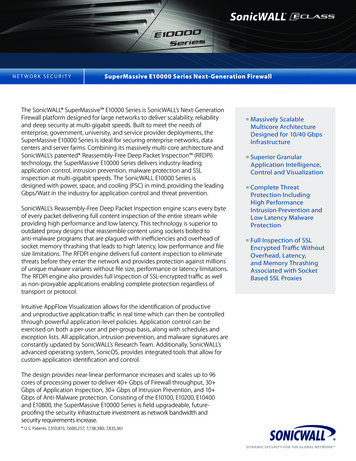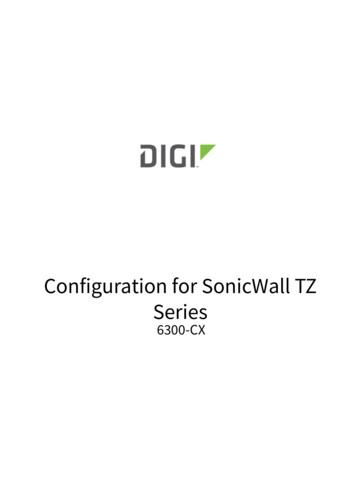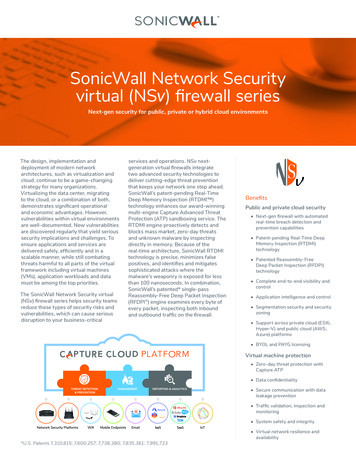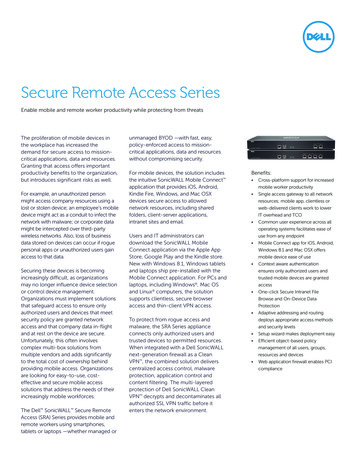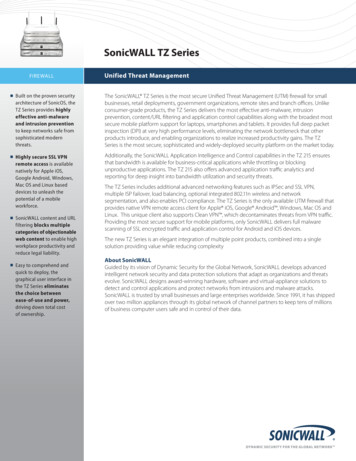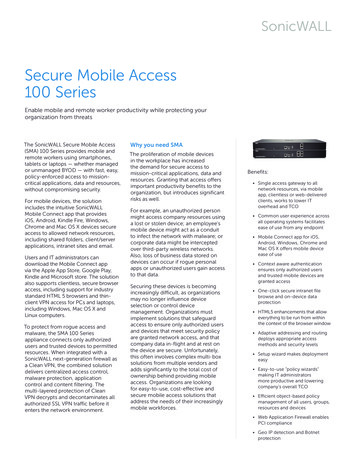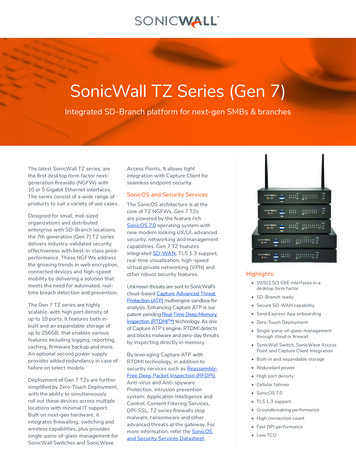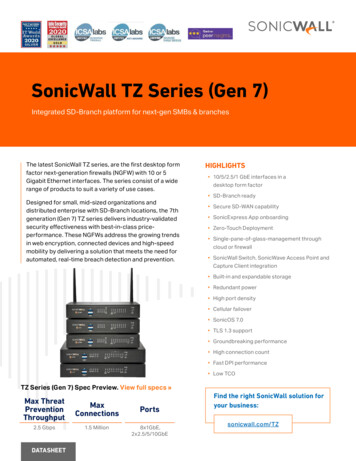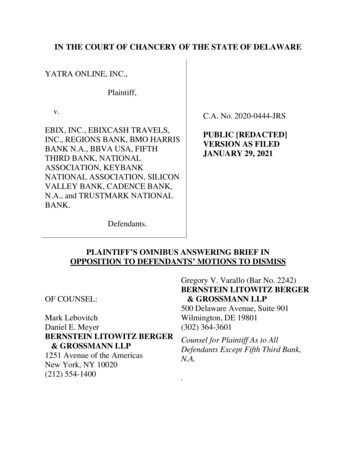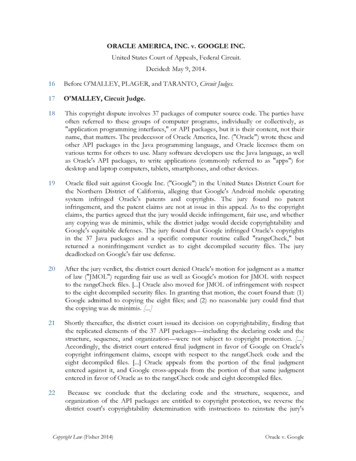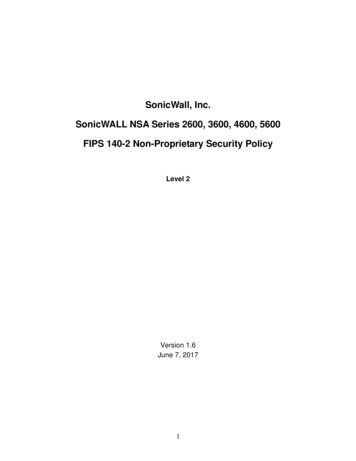
Transcription
SonicWall, Inc.SonicWALL NSA Series 2600, 3600, 4600, 5600FIPS 140-2 Non-Proprietary Security PolicyLevel 2Version 1.6June 7, 20171
Copyright NoticeCopyright 2017 SonicWall, Inc.May be reproduced only in its original entirety (without revision).2
Table of ContentsCopyright Notice . 2Introduction. 4Cryptographic Boundary. 5Roles and Services . 7User Role Services . 7Crypto Officer Services . 8Unauthenticated services . 8Ports and Interfaces . 11Security Rules . 14Operational Environment . 15FIPS 140-2 Approved mode Operation . 15Non-Approved Mode of Operation . 15Definition of Critical Security Parameters. 16Public Keys. 16Definition of CSP Modes of Access. 17Mitigation of Attacks . 19Definitions and Glossary . 193
IntroductionThe SonicWALL NSA Series 2600, 3600, 4600, 5600 (hereafter referred to as “the cryptographicmodule”) is a multiple-chip standalone cryptographic module, with hardware part numbers andversions as follows:ModuleNSA 2600NSA 3600NSA 4600NSA 5600Hardware VersionP/N: 101-500362-63, Rev. AP/N: 101-500338-64, Rev. AP/N: 101-500365-64, Rev. AP/N: 101-500360-65, Rev. AFirmware VersionSonicOS v6.2.5SonicOS v6.2.5SonicOS v6.2.5SonicOS v6.2.5The overall FIPS validation level for the module is Security Level 2. Note that the differenthardware versions vary only in form factor, CPU and memory. The cryptographic module is anInternet security appliance, which provides stateful packet filtering firewall, deep packet inspection,virtual private network (VPN), and traffic shaping services. The appliance Encryption technologyuses Suite B algorithms. Suite B algorithms are approved by the U.S. government for protectingboth Unclassified and Classified data.Table 1 – Module Security Level SpecificationSecurity Requirements SectionCryptographic Module SpecificationCryptographic Module Ports InterfacesRoles, Services, and AuthenticationFinite State MachinePhysical SecurityOperational EnvironmentCryptographic Key ManagementEMI/EMCSelf-TestsDesign AssuranceMitigation of Other Attacks4Level32222N/A2223N/A
Cryptographic BoundaryThe cryptographic boundary is the surfaces and edges of the device enclosure, inclusive of thephysical ports.The chassis of the modules are sealed with one (1) or two (2) tamper evident seals: one (1) tamperevident seal for the NSA 2600 and two (2) tamper-evident seals for the NSA 3600, 4600 and 5600,which are applied during manufacturing. The physical security of the module is intact if there is noevidence of tampering with the seals. The locations of the tamper-evident seals are indicated by thered arrows in the figures below. The Cryptographic Officer shall inspect the tamper seals for signsof tamper evidence once every six months. If evidence of tamper is found, the CryptographicOfficer is requested to follow their internal IT policies which may include either replacing the unit orresetting the unit to factory defaults. For further instructions on resetting to factory defaults, pleasereview Sonicwall guidance documentation.1Figure 1 - NSA 2600 Front with Tamper-Evident Seal on Left Side5
1Figure 2 - NSA 2600 Underside/Bottom (same seal)12Figure 3 - NSA 3600/4600/5600 Rear with Two Tamper-Evident Seals-6
Roles and ServicesThe cryptographic module provides a User role and a Cryptographic Officer role via role-basedauthentication. The cryptographic module does not provide a Maintenance role. The User role isreferred to as “Limited Administrator” (individual user) or “Limited Administrators” (user group) inthe vendor documentation. The Cryptographic Officer role is referred to as “Administrator”(individual user) or “SonicWALL Administrators” (user group) in the vendor documentation. The“Administrator” user is a local account on the SonicWALL appliance, and the name used to login asthis account may be configured by the Cryptographic Officer role; the default name for the“Administrator” account is “admin”. The user group “SonicWALL Read-Only Admins” satisfiesneither the Cryptographic Officer nor the User Role, and should not be used in FIPS modeoperations.The configuration settings required to enable FIPS mode are specified on page 15 of this document.The User role is authenticated using the credentials of a member of the “Limited Administrators”user group. The User role can query status and non-critical configuration. The authenticationmechanisms are discussed in the Security Rules Section.User Role Services Show Status – Monitoring, pinging, traceroute, viewing logs.Show Non-critical Configuration – “Show” commands that enable the User to view VPNtunnel status and network configuration parameters.Session Management – Limited commands that allow the User to perform minimal VPNsession management, such as clearing logs, and enabling some debugging events. Thisincludes the following services:1. Log On2. Monitor Network Status3. Log Off (themselves and guest users)4. Clear Log5. Export Log6. Filter log7. Generate Log Reports8. Configure DNS SettingsTLS – TLS used for the https configuration tool or network traffic over a TLS VPNIPsec VPN – Network traffic over an IPsec VPNThe Cryptographic Officer role is authenticated using the credentials of the “Administrator” useraccount (also referred to as “Admin”), or the credentials of a member of the “SonicWALLAdministrators” user group. The use of the latter allows for identification of specific users (i.e. byusername) upon whom is imparted full administrative privileges through their assigned membershipto the “SonicWALL Administrators” group by the Admin user, or other user with full administrativeprivileges. The Cryptographic Officer role can show all status and configure cryptographicalgorithms, cryptographic keys, certificates, and servers used for VPN tunnels. The Crypto Officersets the rules by which the module encrypts and decrypts data passed through the VPN tunnels. Theauthentication mechanisms are discussed in the Security Rules Section.7
Crypto Officer Services Show Status - Monitoring, pinging, traceroute, viewing logs.Configuration Settings – System configuration, network configuration, User settings,Hardware settings, Log settings, and Security services including initiating encryption,decryption, random number generation, key management, and VPN tunnels. This includesthe following services:1. Configure VPN Settings2. Set Content Filter3. Import/Export Certificates4. Upload Firmware5. Configure DNS Settings6. Configure AccessSession Management – Management access for VPN session management, such as settingand clearing logs, and enabling debugging events and traffic management. This includes thefollowing services:1. Log on2. Import/Export Certificates3. Clear Log4. Filter Log5. Export Log6. Setup DHCP Server7. Generate Log ReportsKey Zeroization – Zeroizing cryptographic keysTLS – TLS used for the https configuration tool or network traffic over a TLS VPNIPsec VPN – Network traffic over an IPsec VPNThe cryptographic module also supports unauthenticated services, which do not disclose, modify, orsubstitute CSPs, use approved security functions, or otherwise affect the security of thecryptographic module.Unauthenticated services Self-test Initiation – power cycle Firmware removal with configuration return to factory state – reset switch. Status – LED activity and console message displayNote: The same services are available in the non-Approved mode of operation. In the non-Approvedmode of operation, the non-Approved algorithms listed on page 16 can be utilized.Separation of roles is enforced by requiring users to authenticate using either a username andpassword, or digital signature verification. The User role requires the use of a username andpassword or possession of a private key of a user entity belonging to the “Limited Administrators”group. The Cryptographic Officer role requires the use of the “Administrator” username andpassword, or the username and password of a user entity belonging to the “SonicWALLAdministrators” group.8
Multiple users may be logged in simultaneously, but only a single user-session can have fullconfiguration privileges at any time, based upon the prioritized preemption model described below:1. The Admin user has the highest priority and can preempt any users.2. A user that is a member of the “SonicWALL Administrators” user group can preempt anyusers except for the Admin.3. A user that is a member of the “Limited Administrators” user group can only preempt othermembers of the “Limited Administrators" group.Session preemption may be handled in one of two ways, configurable from the System Administration page, under the “On admin preemption” setting:1. “Drop to non-config mode” – the preempting user will have three choices:a. “Continue” – this action will drop the existing administrative session to a “non-configmode”, and will impart full administrative privileges to the preempting user.b. “Non-Config Mode” – this action will keep the existing administrative session intact,and will login the preempting user in a “non-config mode”c. “Cancel” – this action will cancel the login, and will keep the existing administrativesession intact.2. “Log-out” – the preempting user will have two choices:a. “Continue” – this action will log out the existing administrative session, and willimpart full administrative privileges to the preempting user.b. “Cancel” – this action will cancel the login, and will keep the existing administrativesession intact.“Non-config mode” administrative sessions will have no privileges to cryptographic functionsmaking them functionally equivalent to User role sessions. The ability to enter “Non-config mode”may be disabled altogether from the System Administration page, under the “On adminpreemption” setting by selecting “Log out” as the desired action.The cryptographic module provides several security services including VPN and IPsec. Thecryptographic module provides the Cryptographic Officer role the ability to configure VPN tunnelsand network settings.When configured to operate in FIPS mode, the cryptographic module provides only FIPS 140-2compliant services. Whether or not the device is in FIPS mode is indicated on the System/Settingspage; checking the FIPS mode enable check box causes the module to execute a compliance check;the module sets the flag only when all conditions are met, and automatically resets the module toenter the FIPS 140-2 Approved mode.9
The module supports the following FIPS-approved cryptographic algorithms:Table 2 – FIPS 140-2 Approved Cryptographic AlgorithmsDescriptionCert. #AES (128, 192, and 256-bit) in CBC mode3901SHA-1, SHA-256, -384, -5123214FIPS 186-4 RSA Key Generation, Signature Generation and Signature Verificationusing 2048 and 3072-bit key sizes with SHA-256, -384, and -5121986FIPS 186-4 DSA Signature Verification using 2048-bit key size with SHA-256, -384and -512.1061HMAC-SHA-1, -256, -384, -5122531SP 800-90A Hash DRBG (SHA-256)1117SP 800-135 KDF's for IKE v1, IKE v2, TLS *756* The corresponding protocols were not reviewed or tested by the CAVP or CMVP.The CAVP certificates associated with this module include other algorithms, modes, and key sizesthat have been CAVP validated but are not available in the Approved mode of the module. Only thealgorithms, modes, and key sizes shown in Table 2 are available in the Approved mode of themodule.The Cryptographic Module also provides the following non FIPS-approved but allowed algorithms: Diffie-Hellman within IKE using 2048-bit keys (key agreement; key establishmentmethodology provides 112 bits of encryption strength) NDRNG (used to seed the Approved DRBG). The NDRNG provides an effective 768 bits ofentropy input to the SP 800-90A Hash DRBG for use in key generation. MD5 within TLS and internal password storage10
Ports and InterfacesFigure 1 - NSA 2600 Front Panel (Top) and Back Panel (Bottom)11
Figure 2 - NSA 3600/4600/5600 Front Panel (Top) and Back Panel (Bottom)Table 3 describes the physical ports and corresponding logical interfaces.12
Table 3 – Ports and InterfacesPhysical PortsQty. DescriptionLogical InterfacesConsole1DB-9/RJ-45 serial connector. Provides a serialconsole which can be used for basic administrationfunctions.Data input, controlinput , status outputUSB2Non-functional, not currently supportedN/AReset Button1Used to manually reset the appliance to Safe Mode.Control inputStatus LEDs6Power LEDs: Indicate module is receiving power.Test LED: Indicates module is initializing andperforming self-tests.Alarm LED: Indicates alarm condition.HD and Bypass Status LEDs: 2600 onlyM0: Expansion Module 0 activity All but 2600Status outputExpansion1Expansion connector, unused, disconnectedinternally. Located in the front panel on the 2600,and in the rear panel in all other configurations.N/ASDHC1Secure Digital High-Capacity port. Non-functional,not currently supported.N/AMGMT11Gbps RJ45 isolated out-of-band management(MGMT) port, with integral LINK and ACT LEDsControl input, statusoutputEthernet [2600]810/100/1000 auto-sensing with an RJ-45/SX/SCmultimode fiber connector. Labeled X#.,LAN/WAN/ . Each Ethernet interface includesLINK and ACT LEDs.Data input, dataoutput, statusoutput, control inputEthernet12[3600,4600,5600]10/100/1000 auto-sensing with an RJ-45/SX/SCmultimode fiber connector. Labeled X#.,LAN/WAN/ . Each Ethernet interface includesLINK and ACT LEDs.Data input, dataoutput, statusoutput, control input1GE SFP41GbE Ethernet hot-pluggable SFP interfacessupporting RJ-45/SX/SC multimode fiber connectorwith LINK and ACT LEDs.Data input, dataoutput, statusoutput, control input10GE SFP210GbE Ethernet hot-pluggable SFP interfaces withLINK and ACT LEDsData input, dataoutput, statusoutput, control inputPower1AC power input and switchPower13
Security RulesThe cryptographic module has the following security rules: The cryptographic module provides two distinct operator roles: User role and CryptographicOfficer role.The cryptographic module provides authentication relying upon username/passwords or anRSA 2048-bit digital signature verification.o The CO and User passwords must be at least eight (8) characters long each, and thepassword character set is ASCII characters 32-127, which is 96 ASCII characters.This makes the probability 1 in 96 8, which is less than one in 1,000,000 that arandom attempt will succeed or a false acceptance will occur for each attempt (Thisis also valid for RADIUS shared secret keys). After three (3) successive unsuccessfulpassword verification tries, the cryptographic module pauses for one second beforeadditional password entry attempts can be reinitiated. This makes the probabilityapproximately 180/96 8 1.5E-14, which is less than one in 100,000, that a randomattempt will succeed or a false acceptance will occur in a one-minute period.o For User authentication based on RSA digital signature verification, the probabilitythat a random attempt will succeed or a false acceptance will occur is 1/2 112, whichis less than 1 in 1,000,000. Due to processing and network limitations, the modulecan verify at most 300 signatures in a one minute period. Thus, the probability that arandom attempt will succeed or a false acceptance will occur in a one minute periodis 300/2 112, which is less than 1 in 100,000.The following cryptographic algorithm self-tests are performed by the cryptographic moduleat power-up:o Firmware integrity test (using 16-bit CRC EDC)o AES-CBC Encrypt and Decrypt Known Answer Testso SHA-1, -256, -384, -512 Known Answer Testso HMAC-SHA-1, -256, -512 Known Answer Testso DSA Signature Verification Pairwise Consistency Testo RSA Sign and Verify Known Answer Testso DH Pairwise Consistency Testo DRBG KAT The module supports the following conditional self-tests:o DRBG and NDRNG Continuous Random Number Generator Testso RSA Pairwise Consistency Testo Firmware Load Test When a new firmware image is loaded, the cryptographic module verifies the 2048-bit DSAsigned SHA-2 hash of the image. If this verification fails, the firmware image loading isaborted.If any of the tests described above fail, the cryptographic module enters the error state. No securityservices are provided in the error state. Upon successful completion of the Diagnostic Phase, thecryptographic module enters the Command and Traffic Processing State. Security services are only14
provided in the Command and Traffic Processing State. No VPN tunnels are started until all testsare successfully completed. This effectively inhibits the data output interface.When all tests are completed successfully, the Test LED is turned off.Operational EnvironmentArea 6 of the FIPS 140-2 requirements does not apply to this module as the module only allows theloading of firmware through the firmware load test, which ensures the image is appropriately DSAsigned by SonicWall, Inc.FIPS 140-2 Approved mode OperationThe module is not configured to operate in FIPS-mode by default. The following steps must betaken to enable FIPS-mode operation. Set Administrator and User passwords, as well as the RADIUS shared secret, to at least eightcharacters.Traffic between the module and the RADIUS server must be secured via an IPsec tunnel.Note: this step need only be performed if RADIUS is supported.Use IKE with 3rd Party Certificates for IPsec Keying Mode when creating VPN tunnels.When creating VPN tunnels, ensure ESP is enabled for IPsec.Use FIPS-approved encryption and authentication algorithms when creating VPN tunnels.Use Group 2 or Group 5 for IKE Phase 1 DH Group and Use SHA-256 for Authentication.Do not enable Advanced Routing Services.Do not enable Group VPN management.Do not enable SNMP or SSH.Enable FIPS mode from the System/Settings page by checking “FIPS Mode” checkbox.The FIPS mode configuration can be determined by an operator, by checking the state of the “FIPSMode” checkbox on the System/Settings page and verification of the preceding steps. When the“FIPS Mode” checkbox is selected, the module executes a compliance checking procedure,examining all settings related to the security rules described above and in this Security Policy, andreporting any non-compliant settings. The operator, prompted by the compliance tool, is responsiblefor updating these settings appropriately. The “FIPS Mode” checkbox and corresponding systemflag will not
Jun 07, 2017 · 1 SonicWall, Inc. SonicWALL NSA Series 2600, 3600, 4600, 5600 FIPS 140-2 Non-Pro
